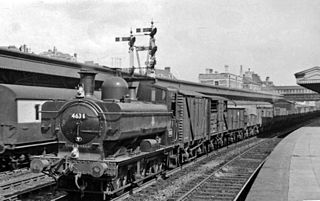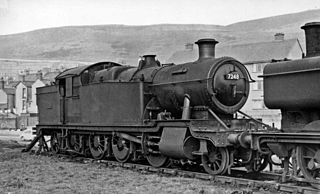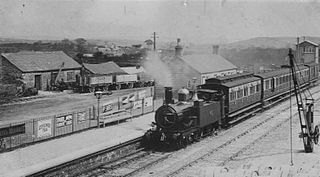
The GWR 5700 Class is a class of 0-6-0 pannier tank steam locomotive built by the Great Western Railway (GWR) and British Railways (BR) between 1929 and 1950. With 863 built, they were the most prolific class of the GWR, and one of the most numerous classes of British steam locomotive.

The Great Western Railway (GWR) 7200 Class is a class of 2-8-2T steam locomotive. They were the only 2-8-2Ts built and used by a British railway, and the largest tank engines to run on the Great Western Railway.

The Great Western Railway (GWR) 4300 Class is a class of 2-6-0 (mogul) steam locomotives, designed by G.J. Churchward for mixed traffic duties. 342 were built from 1911–1932.

The Great Western Railway (GWR) 5400 Class was a class of 0-6-0 pannier tank steam locomotive. They were similar in appearance to many other GWR tank engines but smaller than the ubiquitous GWR 5700 Class.

The Great Western Railway (GWR) 4500 Class or Small Prairie is a class of 2-6-2T steam locomotives.

The GWR 1901 Class was a class of 120 small 0-6-0ST steam locomotives. Numbered 1901–2020, they were designed by George Armstrong and built at the Wolverhampton railway works, England, of the Great Western Railway between 1881 and 1895. They had wheels of 4 ft 0 in (1.219 m) diameter and a coupled wheelbase of 13 ft 8 in (4.17 m).

The GWR 2021 Class was a class of 140 0-6-0ST steam locomotives. They were built at the Wolverhampton railway works of the Great Western Railway between 1897 and 1905. 1897 was the very year of George Armstrong's retirement, so it is uncertain if the design should be attributed to him or to his superior at Swindon, William Dean.

The GWR 645 Class was a class of 0-6-0ST designed by George Armstrong and built at the Wolverhampton railway works of the Great Western Railway (GWR). Thirty-six were constructed between 1872-3, of which three were built for the South Wales Mineral Railway (SWMR), two for the Carmarthen and Cardigan Railway (C&CR) and the remainder for the GWR. In essence, they were saddle tank versions of his GWR 633 Class of 1871. From 1878, a further 72 of the class, partially enlarged, were added in the 1501 numbering sequence. Unlike the originals, the "1501"s had full-length saddle tanks from the start.
The GWR 378 Class was a class of 30 standard-gauge 2-2-2 steam locomotives on the Great Western Railway in Britain. They were introduced in 1866, and the class remained intact until 1898. Several were altered to the 0-6-0 wheel arrangement, and the last was withdrawn from service in 1920.
The Daniel Gooch standard gauge locomotives comprise several classes of locomotives designed by Daniel Gooch, Superintendent of Locomotive Engines for the Great Western Railway (GWR) from 1837 to 1864.
Between 1854 when the Shrewsbury and Chester and Shrewsbury and Birmingham Railways were absorbed by the Great Western Railway, and 1864 when he moved south to Swindon Works, Joseph Armstrong occupied the post of the GWR's Locomotive Superintendent, Northern Division, at Wolverhampton Works. For ten years the task of providing new locomotives for the GWR's newly acquired standard gauge lines fell jointly to Armstrong and to his superior Daniel Gooch, the railway's principal Locomotive Superintendent who was based at Paddington.
The 806 Class was Joseph Armstrong's last design of 2-4-0 mixed-traffic locomotives for the Great Western Railway, built at Swindon Works in 1873. A further 20 similar locomotives were added by Armstrong's successor William Dean in 1881-2; numbered 2201–2220, these had modern domeless boilers. The class had a similar appearance to the 717 Class but had driving wheels 6 in (152 mm) larger.

The GWR 455 Class, also called the "Metropolitan" or "Metro" Tanks, was a series of 140 2-4-0T locomotives built for the Great Western Railway, originally for their London suburban services, including running on the underground section of the Metropolitan Railway, the source of their nickname. Later on the class was seen on many other parts of the GWR system. Sixty "Metro" Tanks were built, from 1868 onwards, during the lifetime of their designer, Joseph Armstrong. His successor William Dean regarded the class so highly that he would add a further 80, the final 20 examples appearing as late as 1899. The "Metros" were all built at Swindon Works, in nine lots of ten or 20 engines each.
The GWR 322 Class tank engines comprised six Great Western Railway outside-framed 0-6-0 steam locomotives, originally built by Beyer, Peacock and Company as 322 class tender engines, and subsequently rebuilt in 1878–85 as saddle tank locomotives by George Armstrong at Wolverhampton Works.
The GWR 633 Class were 0-6-0Ts designed by George Armstrong and built at the Wolverhampton railway works of the Great Western Railway between November 1871 and April 1872. These were always Southern Division locomotives, but over the years some were fitted to work the Metropolitan lines and played a large role in the transportation of goods from Acton to Smithfield. Unusually, they had side tanks, and inside frames, with wheels of 4 ft 6+1⁄2 in (1,384 mm) in diameter and a wheelbase of 15 ft 6 in (4.72 m). Their weight was 34 long tons 12 cwt. There were twelve locomotives, numbered 633–644.

The GWR Class 850 was an extensive class of small 0-6-0ST locomotives designed by George Armstrong and built at the Wolverhampton railway works of the Great Western Railway between 1874 and 1895. Aptly described as the GWR equivalent of the LB&SCR "Terrier" Class of William Stroudley, their wide availability and lively performance gave them long lives, and eventually they were replaced from 1949 by what were in essence very similar locomotives, the short-lived 1600 Class of Frederick Hawksworth, which in the headlong abandonment of steam outlived them by a mere seven years or so.
The 1016 Class consisted of sixty double framed 0-6-0ST locomotives designed by George Armstrong and built at the Wolverhampton Works of the Great Western Railway between 1867 and 1871. Like the earlier 302 Class of Joseph Armstrong, the 1016s had 4 ft 6 in (1.372 m) wheels and a 15 ft 6 in (4.72 m) wheelbase, dimensions that would remain traditional for the larger GWR pannier tanks right through to Charles Collett's 5700 Class, and with little change to Frederick Hawksworth's 9400 Class of 1947.
The 119 Class of the Great Western Railway consisted of a series of 11 0-6-0ST locomotives. They were numbered 119-21 and 123-30 and had originally been built in 1861 at Swindon Works as tender engines to a design of Daniel Gooch, part of the 79 Class. Their rebirth as tank engines was the result of their being renewed at Wolverhampton railway works under the aegis of George Armstrong between 1878 and 1883.
The Great Western Railway's 1813 Class was a series of 40 0-6-0T built at Swindon Works in two lots of 20 engines each. No. 1813 was sold to the Pembroke & Tenby Railway in May 1883 becoming No.7 Holmwood, retaining this name after being absorbed by the GWR. Nearly all of these engines spent their lives on the GWR's Southern Division.
The GWR 1854 Class was a class of 0-6-0T steam locomotives designed by William Dean and constructed at the Swindon Works of the Great Western Railway. The class used similar inside frames and chassis dimensions to the 1813 Class of 1882-4. In this they differed from the intervening 1661 Class, which had reverted to the double frames of the Armstrong era. Thus the 1854 Class belongs to the "mainstream" of GWR 0-6-0T classes that leads towards the larger GWR pannier tanks of the 20th century.










